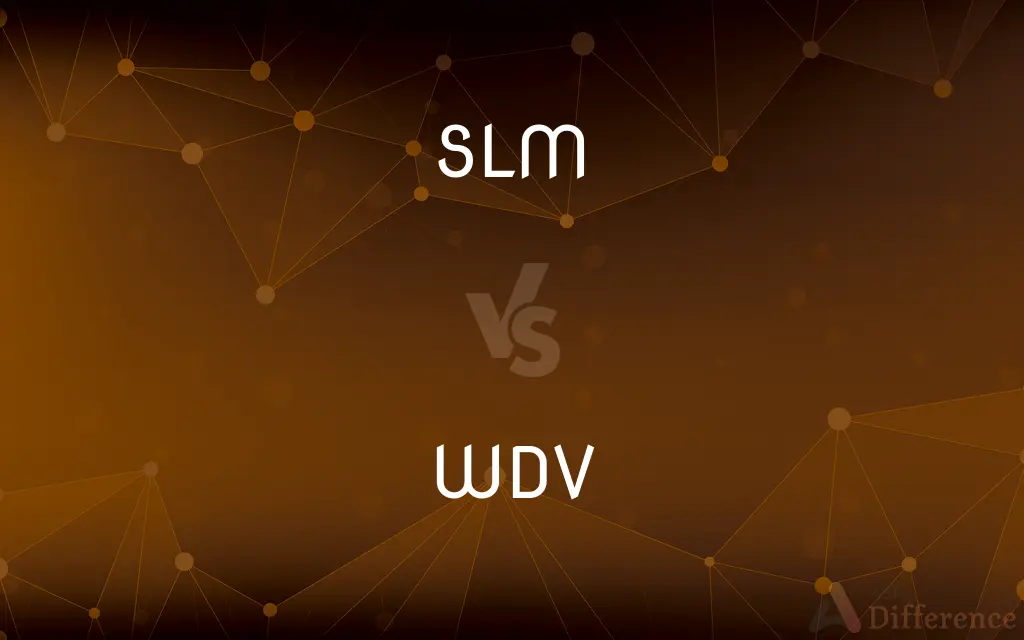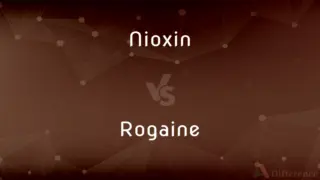SLM vs. WDV — What's the Difference?
By Tayyaba Rehman — Published on December 11, 2023
SLM (Straight-Line Method) depreciates an asset uniformly over its useful life, while WDV (Written Down Value) depreciates it based on a fixed percentage of its remaining value each year.

Difference Between SLM and WDV
Table of Contents
ADVERTISEMENT
Key Differences
SLM and WDV are both methods of calculating depreciation for accounting and tax purposes. While SLM divides the cost of an asset equally over its useful life, WDV reduces its value at a consistent percentage annually.
The primary characteristic of SLM is its consistency. It assigns the same depreciation amount each year. In contrast, WDV starts with higher depreciation values, which gradually decrease each subsequent year as the asset's book value diminishes.
Choosing between SLM and WDV depends on the nature of the asset and the financial strategy of the company. While SLM might be suitable for assets that have a consistent utility over time, WDV is often applied to assets that lose value faster initially.
One of the implications of using SLM is that the book value of the asset becomes zero at the end of its useful life. In contrast, with WDV, the asset's value never truly reaches zero because a percentage of the ever-decreasing residual value is taken each year.
Another distinction between SLM and WDV lies in their impact on financial statements. While SLM results in consistent expenses year after year, WDV affects profitability differently, with larger depreciation charges in earlier years and smaller ones later on.
ADVERTISEMENT
Comparison Chart
Basis of Calculation
Equal amounts over useful life
Percentage of book value each year
Depreciation Pattern
Consistent annual depreciation
Decreasing depreciation each year
End Book Value
Reaches zero
Never truly reaches zero
Impact on Profitability
Consistent impact year after year
Larger impact initially, decreasing over time
Best Used For
Assets with uniform utility over time
Assets that lose value more rapidly initially
Compare with Definitions
SLM
Ensures assets reach a book value of zero after their useful life.
By the end of the fifth year, the SLM will bring the equipment's value to zero.
WDV
Causes higher depreciation charges initially that decrease over time.
Using WDV, our machinery had a steeper depreciation in the first year.
SLM
Provides a uniform expense pattern for financial statements.
The SLM offers stable expenses of $10,000 each year for our fleet.
WDV
Depreciates assets based on a percentage of their remaining value.
The WDV method will result in a $7,000 depreciation expense for the car this year.
SLM
A method that allocates equal depreciation each year.
Using the SLM, the machinery will depreciate at $5,000 annually.
WDV
Ensures assets never depreciate to an exact zero value.
After five years, the asset's value isn't zero due to the WDV approach.
SLM
An approach that divides the total cost by useful life.
According to SLM, the computer's $1,200 cost will be spread over 3 years.
WDV
Alters profitability with changing annual expenses.
In the first few years, WDV significantly impacted our profitability.
SLM
Ideal for assets with a steady utility rate.
For office furniture with a consistent use rate, SLM is appropriate.
WDV
Suitable for assets that rapidly lose value at the start.
For technological equipment that becomes outdated quickly, WDV is preferable.
Common Curiosities
Which method results in a book value of zero at the end of the asset's life?
SLM results in a book value of zero at the end of the asset's useful life.
How does WDV affect a company's profit in the initial years?
WDV has a larger impact on profit in the initial years due to higher depreciation charges.
Why might a company prefer WDV over SLM?
A company might prefer WDV for assets that lose value more quickly in the beginning.
What does SLM stand for in depreciation?
SLM stands for Straight-Line Method.
Which method has a consistent impact on profitability each year?
SLM has a consistent impact on profitability each year.
Does the SLM lead to a constant annual depreciation amount?
Yes, SLM results in a consistent annual depreciation amount.
Can the book value of an asset reach zero using WDV?
No, with WDV, the asset's book value never truly reaches zero.
Which method is preferable for assets with a consistent utility?
For assets with consistent utility, the SLM is preferable.
How does WDV calculate depreciation?
WDV calculates depreciation based on a fixed percentage of the asset's remaining book value each year.
Why is the book value never zero in WDV?
Because WDV takes a percentage of the ever-decreasing residual value each year.
Which method, SLM or WDV, is more common?
The choice depends on the company's assets and financial strategy, but SLM is widely used for its simplicity.
What is the primary characteristic of SLM?
SLM's primary characteristic is its uniform annual depreciation.
Are there tax implications for choosing one method over the other?
Yes, the choice can impact taxable income, and thus taxes owed, so companies must consider tax regulations when selecting a method.
How does the choice of depreciation method impact financial statements?
The choice affects annual expenses, and thus profitability, differently for each method.
Can a company switch between SLM and WDV?
While possible, switches typically require justification and might affect financial reporting.
Share Your Discovery

Previous Comparison
Power Plant vs. Power Station
Next Comparison
Nioxin vs. RogaineAuthor Spotlight
Written by
Tayyaba RehmanTayyaba Rehman is a distinguished writer, currently serving as a primary contributor to askdifference.com. As a researcher in semantics and etymology, Tayyaba's passion for the complexity of languages and their distinctions has found a perfect home on the platform. Tayyaba delves into the intricacies of language, distinguishing between commonly confused words and phrases, thereby providing clarity for readers worldwide.












































